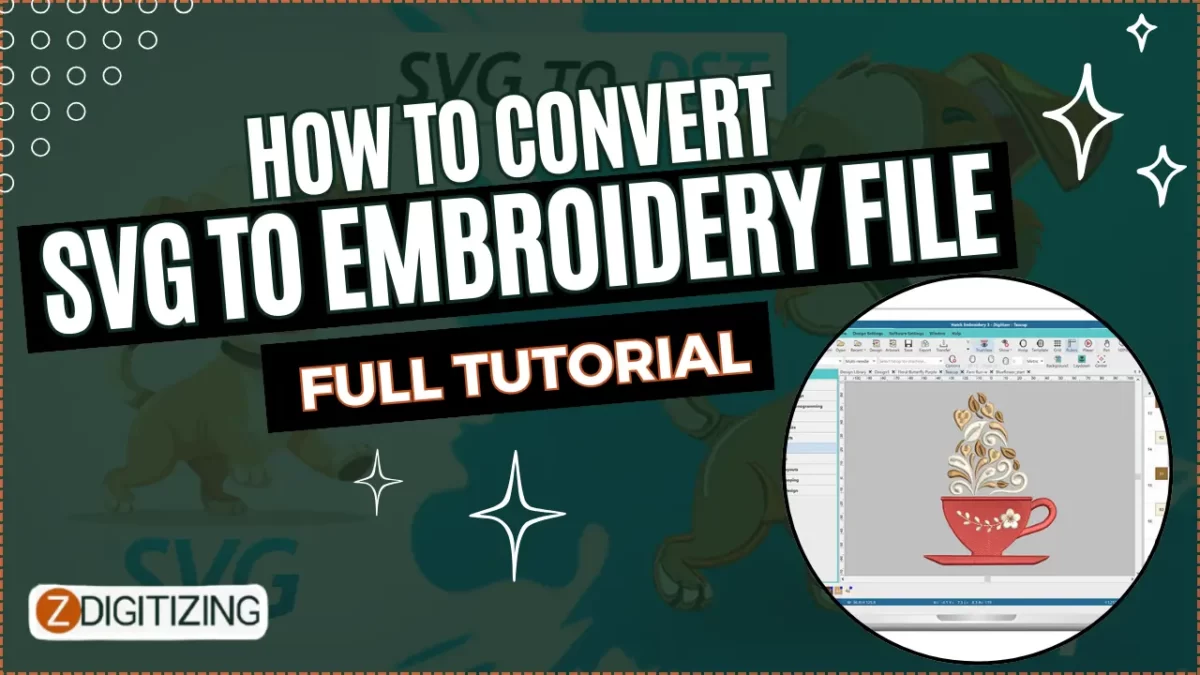Embroidery is an art form that has evolved with technology, and the ability to convert SVG (Scalable Vector Graphics) files to embroidery formats opens up a world of possibilities for enthusiasts and professionals alike. In this step-by-step tutorial, we’ll guide you through the process of converting SVG files to embroidery formats, allowing you to seamlessly translate digital designs into beautifully stitched creations.
Understanding SVG Files and Embroidery Formats
1. SVG Files:
SVG is a versatile vector graphics format widely used for web design, digital illustration, and now, embroidery. SVG files are created with XML-based code, representing scalable two-dimensional graphics that can be resized without loss of quality. The challenge lies in converting this digital vector format into machine-readable embroidery files.
2. Embroidery Formats:
Embroidery machines use specific file formats to interpret and stitch designs. Common embroidery digitizing formats include DST, PES, JEF, and EXP. Converting SVG to these formats requires specialized software that understands the stitching instructions and color codes necessary for embroidery machines.
Step-by-Step Tutorial: Converting SVG to Embroidery Files
Step 1: Choose the Right Conversion Software
To begin the conversion process, select suitable software designed for SVG to embroidery file conversion. Popular choices include:
- Ink/Stitch: A free and open-source extension for Inkscape, offering SVG to embroidery file conversion capabilities.
- Embird: A comprehensive embroidery software that supports various file formats and provides advanced editing features.
- Wilcom Hatch: A professional-grade embroidery software known for its powerful design and editing tools.
Step 2: Install and Set Up the Software
Follow the installation instructions provided by the chosen software. Once installed, configure the settings based on your embroidery machine’s specifications. Ensure the software recognizes the appropriate hoop size and embroidery format.
Step 3: Import the SVG File
Open the SVG file you wish to convert using the selected software. Most conversion tools allow direct importing of SVG files, preserving the vector elements and color information.
Step 4: Edit and Optimize the Design
Before converting, take advantage of the editing features provided by the software. Adjust stitch density, optimize color choices, and fine-tune details to ensure the design translates seamlessly into embroidery.
Step 5: Choose the Embroidery Format
Select the desired embroidery format for your machine. Common formats include DST, PES, JEF, and EXP. The software should have an option to export or save the design in your chosen format.
Step 6: Save the Embroidery File
After selecting the embroidery format, save the converted file to your computer. Choose a location that is easily accessible, as you will need to transfer the file to your embroidery machine.
Step 7: Transfer to Embroidery Machine
Connect your computer to the embroidery machine using a USB cable or the method recommended by your machine’s manufacturer. Transfer the saved embroidery file to the designated folder on the machine or follow the machine-specific instructions for file transfer.
Step 8: Load the Design and Stitch
Once the file is transferred, load it into the embroidery machine. Hoop the fabric securely, ensuring proper alignment. Follow the machine’s instructions for selecting colors and starting the stitching process.
Step 9: Monitor the Stitching Process
Keep a close eye on the embroidery machine as it stitches the design. If any issues arise, such as thread breaks or misalignment, pause the machine and address the problem before continuing.
Step 10: Finishing Touches
After the machine completes the embroidery, carefully remove the fabric from the hoop. Trim any excess threads and inspect the finished design. Admire your transformed SVG file turned into a tangible, embroidered masterpiece.
Tips for Successful SVG to Embroidery Conversion
1. Choose Simple Designs:
Complex SVG designs may not translate well into embroidery. Opt for simpler designs, especially if you’re a beginner in embroidery digitizing.
2. Understand Stitch Types:
Different embroidery machines support various stitch types. Familiarize yourself with the stitch types used in your chosen design and adjust settings accordingly.
3. Consider Color Variations:
Embroidery machines typically have a limited number of thread colors. Adjust the color palette of your SVG design to match the available thread colors.
4. Test Stitch on Scrap Fabric:
Before embroidering on your final project, conduct a test stitch on scrap fabric to ensure the design, colors, and stitch density are satisfactory.
5. Regular Maintenance:
Keep your embroidery machine well-maintained, with clean needles, a properly calibrated hoop, and regularly cleaned and lubricated components.
Conclusion
Converting SVG files to embroidery formats empowers individuals to bring their digital designs to life in a tactile and visually appealing way. With the right software, understanding of the conversion process, and attention to detail, you can seamlessly bridge the digital and embroidery worlds, creating personalized and professionally stitched designs.
As you embark on your journey of SVG to embroidery file conversion, remember that practice and experimentation are key. Each project will enhance your skills, allowing you to unlock new dimensions of creativity through the art of embroidery.
Zdigitizing
We trust this article might really work out for you. To digitize embroiery plan you would require an expert like ZDigitizing, as digitizing is a mind boggling process.
Zdigitizing is a digitizing embroidery service organization that gives embroidery digitizing service and Vector Art Services all around the world to organizations, ventures, and enterprises. zdigitizing gives fashionable, strong, and sensible custom digitizing and vector craftsmanship administrations. We have been conveying first class digitizing embroidery administrations for 20+ years.


